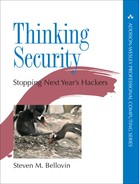Contents
1.4 A Few Words on Terminology
2.3 Security as a Systems Problem
3.3 Advanced Persistent Threats
4.2 The Care and Feeding of Antivirus Software
4.3 Is Antivirus Always Needed?
5 Firewalls and Intrusion Detection Systems
5.3 Intrusion Detection Systems
5.4 Intrusion Prevention Systems
6.1 Cryptography, the Wonder Drug
6.6 Protocol, Algorithm, and Key Size Recommendations
7 Passwords and Authentication
7.8 Cryptographic Authentication
7.10 Single-Sign-On and Federated Authentication
7.11 Storing Passwords: Servers
8 PKI: Public Key Infrastructures
8.4 Certificate Expiration and Revocation
9.4 Smart Phones, Tablets, Toys, and Mobile Phone Access
10.1 Distribution and Isolation
10.5 Security Architecture of Cloud Providers
12.2 Selecting Software Wisely
13 Keeping Software Up to Date
14.1 Employees, Training, and Education
15.1 Sysadmins: Your Most Important Security Resource
15.3 System Administration Tools and Infrastructure
15.4 Outsourcing System Administration
